Analys
Iraqi oil production and exports at stake


The Brent crude oil price spiked 3.6% on Friday to $68.6/bl on the back of the US killing of the Iranian general Qassem Soleimani. This morning it jumps 2.3% to $70.2/bl. Though so far not a single drop of oil supply has been lost.
Iranian retaliation and then US re-retaliation are however imminent. The US has already pre-selected 52 Iranian targets. Eventual loss of supply in the Middle East may however be in Iraq down the road and not so much due to near term retaliations.

US forces in Iraq now seem likely to be kicked out of the country and Iraq will then most likely “fall into the arms of Iran”. As former acting head of the CIA, Michael Morell, put it: “I think we’ve now ended any hope of keeping Iraq out of Iran’s arms.”
If Iran and Iraq become one large Shia Muslim centre of gravity in the Middle East, then US sanctions towards Iran would naturally be extended also to Iraq leading to a decline in Iraqi oil production and exports. This now looks very much like the way it is moving. The U.S. president on Sunday threatened to impose sanctions on Iraq if the Iraqi parliament voted to expel US troops from the country.
It is very clear that if it wasn’t for the fact that the oil market lost more than 3 m bl/d of crude oil supply from Iran and Venezuela since the end of 2016 it would not have been possible for the US to grow its crude oil production by more than 4 m bl/d over the same period and thus become oil independent and still have an oil price today of more than $60/bl. It is also quite clear that the lost supply from Iran and Venezuela to a large degree is the result of US sanctions towards these two nations and that these sanctions basically have paved the way for US oil production growth and oil independence.
It would of course be very bearish for the oil market if supplies from Iran and Venezuela came back into the market. That will probably happen at some point in time. However, we do not think that this will happen any time soon (years). Production and exports from these two countries will most likely be kept out of the market as long as the US needs room to grow its oil production and exports. The more correct focus may instead be to ask who is next in line to be kicked out of the oil market in order to make room for growing US oil production and exports? Right now, it seems likely to be Iraq.
It might be a tall order to accuse Donald Trump of such simple mercantile motives. But we need look no further than to the Russian gas pipeline Nord Stream 2 which stretches from Ust-Luga in Russia through the Baltic Sea and to Greifswald in Germany. In December the U.S. Senate imposed sanctions on companies working on the pipeline in order to prevent it from being completed. Their explanation was that they did it to protect Europe from becoming too dependent on Russian gas exports. But the sanctions are against the will of the EU. As such this looks bluntly as a move by the U.S. to prevent Russian gas flowing to the EU thus making room for growing U.S. gas exports to Europe instead.
The situation for Iran is of course extremely difficult. Donald Trump basically killed on of its highest-ranking generals with a precision drone high in the sky while he was playing golf at his resort in Florida (or at least he was at his resort there). The feeling of helplessness must be pervasive. If Iran now retaliates and kills U.S. armed forces (which seems likely) they will just see more devastating retaliations in return. The only real hope for Iran it seems is if they could get China fully over to their side and ramp up oil exports to China. While China wants its oil it most likely won’t go in the face of the U.S. doing so in large volumes. But if Iranian sanctions are extended also to Iraq it could be different.
Our general view for 2020 is that there will be involuntary losses of supply in the middle east in the year to come. Either through military action like the one in September when Saudi Arabian oil production was cut in half by the drone strike at its Abqaiq oil reprocessing plant or increased U.S. sanctions for example towards Iraq. The Iranian situation was probably the key source of the disruptive events in the middle east in 2019. This “source problem” has now just become much worse. The consequence of these “most likely losses of supply to come” in the middle east will be that the oil price will be elevated, global oil surplus will be avoided, and U.S. oil production growth and exports can re-accelerate again.
Ch1: Cumulative oil production change in the U.S. versus Iran + Venezuela. U.S. production growth would not have been possible without the losses of supplies from Iran and Venezuela and those losses were largely due to sanctions from the U.S.
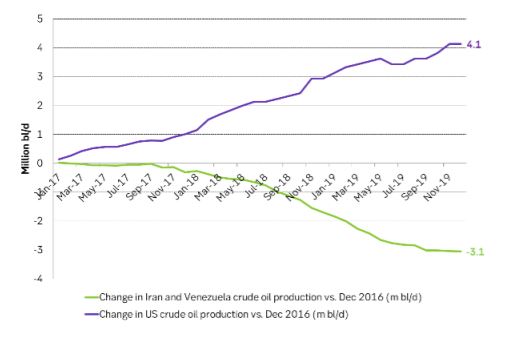
Ch2: Crude oil production in m bl/d in the US, Iran, Iraq and Venezuela
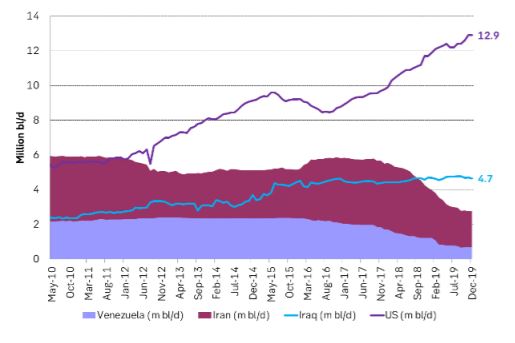
Ch3: Iraq and Iran might be a large Shia Muslim force if Iraq now votes to expel U.S. troops. The U.S. on Sunday threatened Iraq with sanctions if U.S. troops are expelled.

Ch4: The EU wants gas from Russia via the new Nord Stream 2 pipeline. The U.S. doesn’t want it. It want’s to export gas to the EU
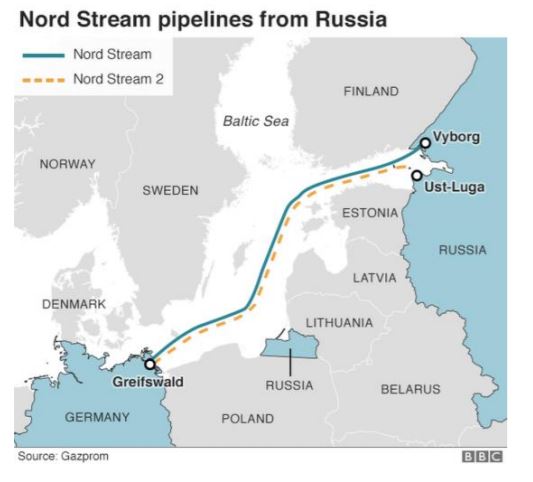
Analys
Brent crude ticks higher on tension, but market structure stays soft

Brent crude has climbed roughly USD 1.5-2 per barrel since Friday, yet falling USD 0.3 per barrel this mornig and currently trading near USD 67.25/bbl after yesterday’s climb. While the rally reflects short-term geopolitical tension, price action has been choppy, and crude remains locked in a broader range – caught between supply-side pressure and spot resilience.

Prices have been supported by renewed Ukrainian drone strikes targeting Russian infrastructure. Over the weekend, falling debris triggered a fire at the 20mtpa Kirishi refinery, following last week’s attack on the key Primorsk terminal.
Argus estimates that these attacks have halted ish 300 kbl/d of Russian refining capacity in August and September. While the market impact is limited for now, the action signals Kyiv’s growing willingness to disrupt oil flows – supporting a soft geopolitical floor under prices.
The political environment is shifting: the EU is reportedly considering sanctions on Indian and Chinese firms facilitating Russian crude flows, while the U.S. has so far held back – despite Bessent warning that any action from Washington depends on broader European participation. Senator Graham has also publicly criticized NATO members like Slovakia and Hungary for continuing Russian oil imports.
It’s worth noting that China and India remain the two largest buyers of Russian barrels since the invasion of Ukraine. While New Delhi has been hit with 50% secondary tariffs, Beijing has been spared so far.
Still, the broader supply/demand balance leans bearish. Futures markets reflect this: Brent’s prompt spread (gauge of near-term tightness) has narrowed to the current USD 0.42/bl, down from USD 0.96/bl two months ago, pointing to weakening backwardation.
This aligns with expectations for a record surplus in 2026, largely driven by the faster-than-anticipated return of OPEC+ barrels to market. OPEC+ is gathering in Vienna this week to begin revising member production capacity estimates – setting the stage for new output baselines from 2027. The group aims to agree on how to define “maximum sustainable capacity,” with a proposal expected by year-end.
While the IEA pegs OPEC+ capacity at 47.9 million barrels per day, actual output in August was only 42.4 million barrels per day. Disagreements over data and quota fairness (especially from Iraq and Nigeria) have already delayed this process. Angola even quit the group last year after being assigned a lower target than expected. It also remains unclear whether Russia and Iraq can regain earlier output levels due to infrastructure constraints.
Also, macro remains another key driver this week. A 25bp Fed rate cut is widely expected tomorrow (Wednesday), and commodities in general could benefit a potential cut.
Summing up: Brent crude continues to drift sideways, finding near-term support from geopolitics and refining strength. But with surplus building and market structure softening, the upside may remain capped.
Analys
Volatile but going nowhere. Brent crude circles USD 66 as market weighs surplus vs risk

Brent crude is essentially flat on the week, but after a volatile ride. Prices started Monday near USD 65.5/bl, climbed steadily to a mid-week high of USD 67.8/bl on Wednesday evening, before falling sharply – losing about USD 2/bl during Thursday’s session.

Brent is currently trading around USD 65.8/bl, right back where it began. The volatility reflects the market’s ongoing struggle to balance growing surplus risks against persistent geopolitical uncertainty and resilient refined product margins. Thursday’s slide snapped a three-day rally and came largely in response to a string of bearish signals, most notably from the IEA’s updated short-term outlook.
The IEA now projects record global oversupply in 2026, reinforcing concerns flagged earlier by the U.S. EIA, which already sees inventories building this quarter. The forecast comes just days after OPEC+ confirmed it will continue returning idle barrels to the market in October – albeit at a slower pace of +137,000 bl/d. While modest, the move underscores a steady push to reclaim market share and adds to supply-side pressure into year-end.
Thursday’s price drop also followed geopolitical incidences: Israeli airstrikes reportedly targeted Hamas leadership in Doha, while Russian drones crossed into Polish airspace – events that initially sent crude higher as traders covered short positions.
Yet, sentiment remains broadly cautious. Strong refining margins and low inventories at key pricing hubs like Europe continue to support the downside. Chinese stockpiling of discounted Russian barrels and tightness in refined product markets – especially diesel – are also lending support.
On the demand side, the IEA revised up its 2025 global demand growth forecast by 60,000 bl/d to 740,000 bl/d YoY, while leaving 2026 unchanged at 698,000 bl/d. Interestingly, the agency also signaled that its next long-term report could show global oil demand rising through 2050.
Meanwhile, OPEC offered a contrasting view in its latest Monthly Oil Market Report, maintaining expectations for a supply deficit both this year and next, even as its members raise output. The group kept its demand growth estimates for 2025 and 2026 unchanged at 1.29 million bl/d and 1.38 million bl/d, respectively.
We continue to watch whether the bearish supply outlook will outweigh geopolitical risk, and if Brent can continue to find support above USD 65/bl – a level increasingly seen as a soft floor for OPEC+ policy.
Analys
Waiting for the surplus while we worry about Israel and Qatar

Brent crude makes some gains as Israel’s attack on Hamas in Qatar rattles markets. Brent crude spiked to a high of USD 67.38/b yesterday as Israel made a strike on Hamas in Qatar. But it wasn’t able to hold on to that level and only closed up 0.6% in the end at USD 66.39/b. This morning it is starting on the up with a gain of 0.9% at USD 67/b. Still rattled by Israel’s attack on Hamas in Qatar yesterday. Brent is getting some help on the margin this morning with Asian equities higher and copper gaining half a percent. But the dark cloud of surplus ahead is nonetheless hanging over the market with Brent trading two dollar lower than last Tuesday.

Geopolitical risk premiums in oil rarely lasts long unless actual supply disruption kicks in. While Israel’s attack on Hamas in Qatar is shocking, the geopolitical risk lifting crude oil yesterday and this morning is unlikely to last very long as such geopolitical risk premiums usually do not last long unless real disruption kicks in.
US API data yesterday indicated a US crude and product stock build last week of 3.1 mb. The US API last evening released partial US oil inventory data indicating that US crude stocks rose 1.3 mb and middle distillates rose 1.5 mb while gasoline rose 0.3 mb. In total a bit more than 3 mb increase. US crude and product stocks usually rise around 1 mb per week this time of year. So US commercial crude and product stock rose 2 mb over the past week adjusted for the seasonal norm. Official and complete data are due today at 16:30.
A 2 mb/week seasonally adj. US stock build implies a 1 – 1.4 mb/d global surplus if it is persistent. Assume that if the global oil market is running a surplus then some 20% to 30% of that surplus ends up in US commercial inventories. A 2 mb seasonally adjusted inventory build equals 286 kb/d. Divide by 0.2 to 0.3 and we get an implied global surplus of 950 kb/d to 1430 kb/d. A 2 mb/week seasonally adjusted build in US oil inventories is close to noise unless it is a persistent pattern every week.
US IEA STEO oil report: Robust surplus ahead and Brent averaging USD 51/b in 2026. The US EIA yesterday released its monthly STEO oil report. It projected a large and persistent surplus ahead. It estimates a global surplus of 2.2 m/d from September to December this year. A 2.4 mb/d surplus in Q1-26 and an average surplus for 2026 of 1.6 mb/d resulting in an average Brent crude oil price of USD 51/b next year. And that includes an assumption where OPEC crude oil production only averages 27.8 mb/d in 2026 versus 27.0 mb/d in 2024 and 28.6 mb/d in August.
Brent will feel the bear-pressure once US/OECD stocks starts visible build. In the meanwhile the oil market sits waiting for this projected surplus to materialize in US and OECD inventories. Once they visibly starts to build on a consistent basis, then Brent crude will likely quickly lose altitude. And unless some unforeseen supply disruption kicks in, it is bound to happen.
US IEA STEO September report. In total not much different than it was in January
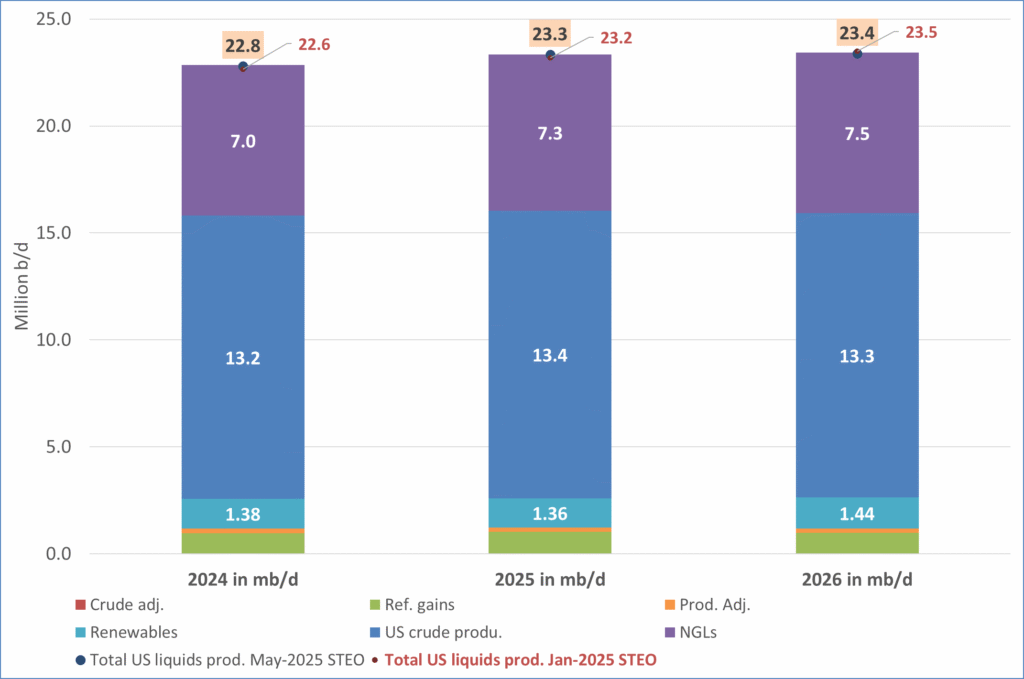
US IEA STEO September report. US crude oil production contracting in 2026, but NGLs still growing. Close to zero net liquids growth in total.
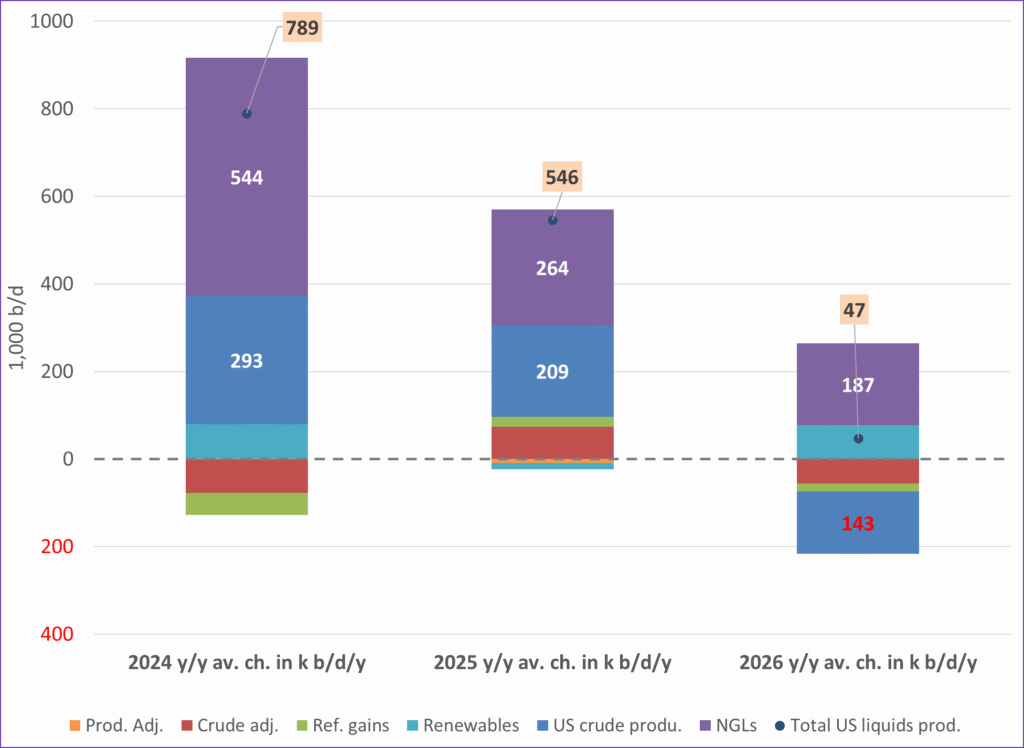
-
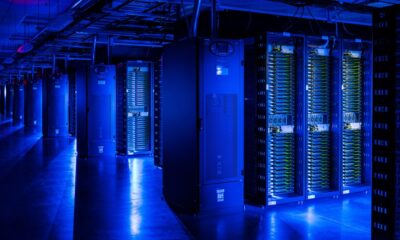
 Nyheter4 veckor sedan
Nyheter4 veckor sedanMeta bygger ett AI-datacenter på 5 GW och 2,25 GW gaskraftverk
-

 Nyheter4 veckor sedan
Nyheter4 veckor sedanAker BP gör ett av Norges största oljefynd på ett decennium, stärker resurserna i Yggdrasilområdet
-

 Nyheter4 veckor sedan
Nyheter4 veckor sedanSommarens torka kan ge högre elpriser i höst
-

 Analys4 veckor sedan
Analys4 veckor sedanBrent edges higher as India–Russia oil trade draws U.S. ire and Powell takes the stage at Jackson Hole
-

 Nyheter3 veckor sedan
Nyheter3 veckor sedanMahvie Minerals är verksamt i guldrikt område i Finland
-

 Analys4 veckor sedan
Analys4 veckor sedanIncreasing risk that OPEC+ will unwind the last 1.65 mb/d of cuts when they meet on 7 September
-

 Nyheter3 veckor sedan
Nyheter3 veckor sedanNeil Atkinson spår att priset på olja kommer att stiga till 70 USD
-

 Analys2 veckor sedan
Analys2 veckor sedanOPEC+ in a process of retaking market share









